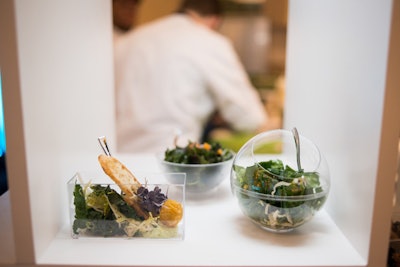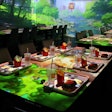
Now that every guest has a smartphone capable of proliferating an event’s message on social media, event organizers need to make sure that the messages guests share are on-brand and high quality. So buffets that are picked over, unappetizing, or untidy are out of the question—especially at a time when food is such a popular event element to capture and share. Caterers and event designers contributed their tips on how to keep buffets appetizing, on-message, and Instagram-ready at all times.
1. Think up, not just across.
The traditional buffet station sprawls across a horizontal surface, but caterers suggest thinking differently to achieve appealing presentations. “The visual display of the buffet is as important as the ingredients in the dishes. We use various serving vessels, trays, and risers to present a gorgeous array of dishes,” says vice president of national sales for Wolfgang Puck Catering Stephanie Edens. “So, as an alternative to the standard banquet table, we now offer a vertical buffet to provide another level of interest, displaying the food as an objet d’art versus on a [traditional] buffet.”
Sterling Engagements principal and creative director Alexandra Rembac echoes, “I also love stairs and tiers and layers.” And she says they can keep a buffet looking appetizing as an event wears on: “I think these components can really help stretch a station past its time.”
Teresa MacPherson, general manager of off-site catering operations for Patina Restaurant Group, adds, “Draw interest by creating depth using innovative risers and tiers to display food on various levels. Add height in your display to maximize your working space and create a photo op.”
2. Consider buffets part of the decor.
Most than just places to connect guests with food, buffet stations can be an integrated part of event decor that encourages guests to linger—and entices them to capture photos. “We try to approach our buffets and stations as part of the decor. Whether it’s a minimal enhancement or full-scale station design, the ultimate goal is always to touch it with a little love—sometimes that’s just a rich linen, signage, and some blooms, and sometimes it’s backdrops, suspended florals, and props,” Rembac says. “Oversize signage and greenery always go a long way as well. Fun phrases, visuals, and wit help really make it look cohesive but also shift the focus [away from dwindling food supply], if and when we need it. If a station is being hit hard but has great visuals and decor as the replenishing is happening, sometimes these visuals distract and still give guests something great to look at.”
Patina’s MacPherson suggests looking outside the food and event world for inspiration for a truly Instagram-worthy buffet. “Pull inspiration from other industries including fashion, interior decor, and graphic design to create a cohesive display incorporating current trends. Tie in custom signage and a current color palette for the ultimate photo-worthy moment.”
3. Communicate across vendors.
Attractive buffets depend on communication across planners, caterers, designers, and other vendors—both before and during an event. “[As producers and designers], we try to always have the conversation [with caterers] about their food, how they want to serve it, and equipment we will be sourcing early,” Rembac says. “We work with our chefs to design the menu, and then often their stations are an extension of that. So it all comes full circle.”
4. Materials matter.
MacPherson says, “Take a twist on a classic buffet display by adding in an unexpected assortment of materials—using anything from shiny brass trays, to sleek marble cake stands, to rustic live-edge wood.”
She suggests pulling in “various resources that are outside the box. Use a clamshell to house a seafood salad, or a marble tile as a serving tray. Utilize florals, industrial materials, and anything else you can imagine to shake it up.”
She adds that an element of surprise goes a long way toward enticing guests to share on social: “Create a compelling moment by incorporating edible vessels for an interactive station full of surprises. Using a chocolate shell bowl for desserts, or an edible leaf as an innovative appetizer tray.”
5. Ensure speedy service.
Of course, heavily trafficked food stations need continual attention to stay looking their best, so make sure there is adequate, and adequately trained, staff on hand to make it happen. “We always try to work with service to ensure the stations are constantly monitored and loved,” Rembac says. “Even if food isn’t being replenished necessarily, eyes should be on the tables and assisting with rearranging to continue to make it look full whether at 95 percent, at 50 percent, or at 35 percent. There’s ways to continue to push it forward and spread it out to make that happen—those details are so important.”



















